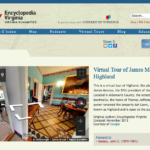Introduction
Public historians have, at their fingertips, digital tools that help their institution reach and engage with a wide online audience – whether it’s a museum, historical organization, reenactment group, etc. These digital tools sound great, but it can be overwhelming to think about where to begin and how to gauge whether you’re doing it “correctly.”
Social media
Some of our readings talked about blogging, and maybe it’s just that I live under a rock in the back of a cave, but I think that blogs are a bit passé. I don’t know that we (the collective online audience) have ever had a stellar attention span, but in 2020, it’s gnat-like, at best, which is why I think that social media tools like Twitter, Instagram, and Facebook are the most effective tools for public historians to use to ensure that they’re not left behind in the technology whirlwind.
For instance, with everything that’s going on right now, Belle Grove started posting daily “Total Positivity” messages on their Facebook page – or “TP,” poking fun at the current toilet paper shortage. They’ve been posting something positive every day since March 14, and it’s been a way to create a cheerier mood against a not-so-cheery backdrop while also staying current in everyone’s Facebook feeds. They’ve been sharing everything from pictures of the property in full spring bloom, to partnerships they have with local organizations, to a cameo of the Belle Grove cat, Maury.
We’re living in an interesting moment in terms of social media and historical institutions. Look at Belle Grove, for instance. Before social media, it’s highly likely that their current work would’ve fallen off of everyone’s radar because there would’ve been limited ways for the Belle Grove staff to reach/communicate with the community. With social media, they’re able to talk directly to their audience and keep them in the loop on the latest happenings around the property, despite the fact that it’s closed to the public right now. This luxury is a fairly new one for public historians, and I think that we’re seeing its positive effect now more so than ever before.
Virtual reality
Public historians are operating in an arena that allows them to keep the past present – not only via social media presence, but also by the use of digital exhibits. I’m not talking about just digital archiving, which we shouldn’t diminish, but rather this ability to make history come alive. On my summer bucket list (if we’re ever able to come out of hiding) is to visit is James Monroe’s Highland down in Charlottesville. They have a virtual reality experience that allows visitors to the physical site (not the website) to “experience” the property in 1819:
Augmented reality (AR) offers a new way to experience history at Highland. Through state-of-the-art Smart Glasses, visitors will witness conversations between individuals experiencing life at Highland in the year 1819, and learn about the archaeology and dendrochronology that led to the dramatic reinterpretation of the Highland landscape. A highlight of the new augmented reality tour is the digital rendering of the 1799 Monroe main house, lost to fire after Monroe sold the property.

The AR is an innovative enhancement for physical visitors, but that leaves out an entire non-physical audience, so Highland’s website also offers a virtual tour where you can experience the inside and outside of the property using Google maps.
I call out this property because I think that they’ve done a solid job of blending digital tools with traditional historical methodologies. In doing so, they’re modernizing history.